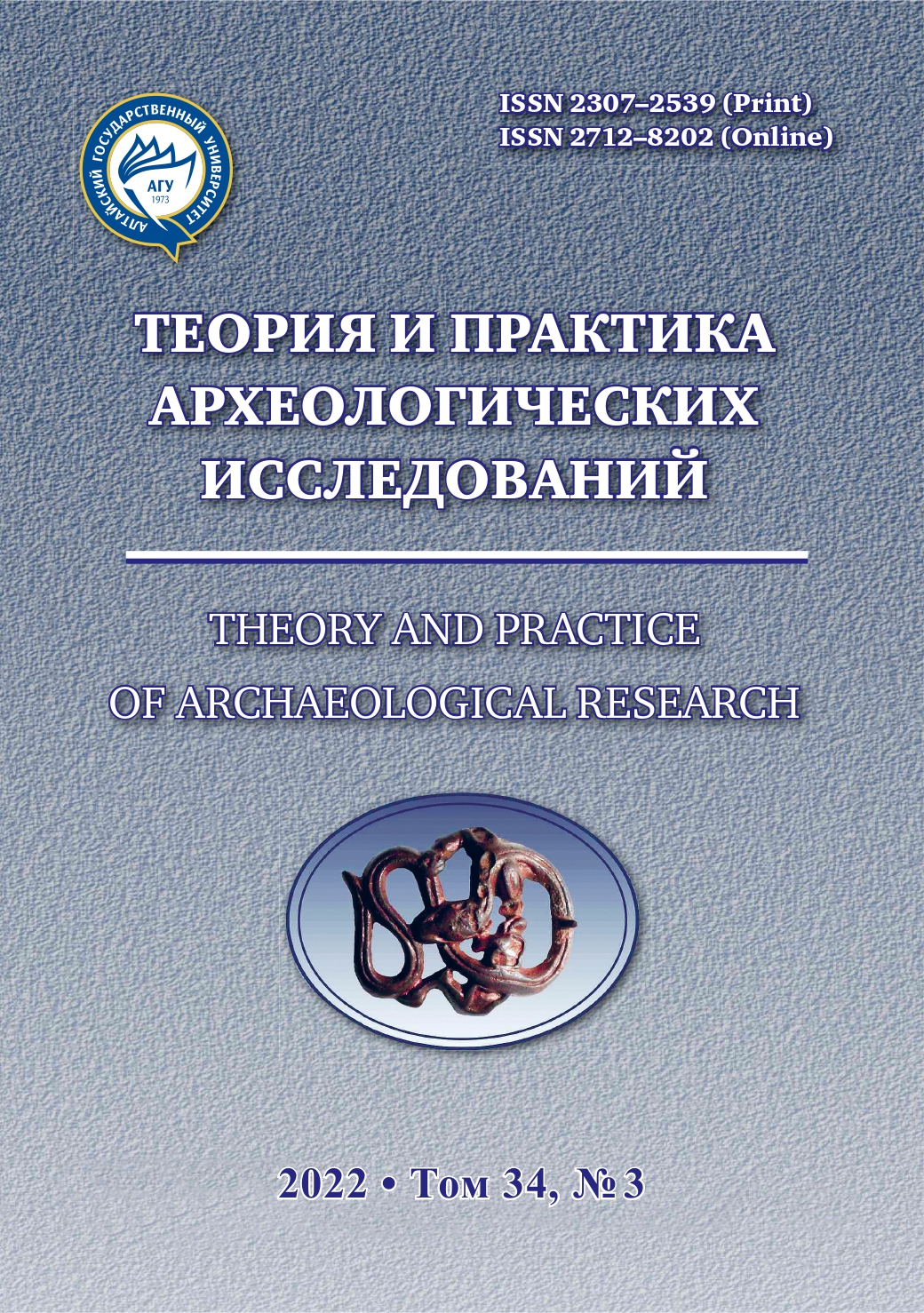ETHNOZOOLOGY FOR ARCHAEOLOGY: RESULTS OF THE STUDY OF THE MODERN LIVESTOCK BREEDING SYSTEM IN THE STEPPE ZONE OF THE SOUTHERN URALS
Abstract
The work is devoted to a detailed study of modern livestock breeding in the south of the Chelyabinsk region. The article describes in detail the system of grazing and keeping livestock in the summer and winter periods in the villages of the Southern Urals. The main purpose of the work is to create an information basis for future archaeological and archaeozoological studies of the sites of pastoralists of the Bronze Age and more correct interpretations in the reconstruction of ancient pastoralism. The main research tools were interviewing shepherds and personal observations of grazing and keeping livestock at diff erent times of the year. The main form of grazing and keeping livestock at present is the pasture-stall system, which is quite variable depending on various factors. The warm period of the year is characterized by grazing in the vicinity of villages and stall keeping in the cold season. The study shows the wide possibilities and resistance of small areas of the steppe river valleys to grazing. The results of the study of modern pastoralism can be used in archaeological research in various studies that are associated with a settled model of pastoralism.
Downloads
Metrics
References
Kosintsev P. A. Bone Remains of Animals from the Fortifi ed Settlement of Arkaim. In: Archaeological Source and Modeling of Ancient Technologies. Proceedings of the Museum-Reserve Arkaim. Chelyabinsk : Institut istorii i arheologii UrO RAN, 2000. Pp. 17–44. (In Russ.)
Lugli F. Th e Use of Space in the Winter Camps of Steppe Pastoralists — an Ethnoarchaeological Point of View. Vestnik Tomskogo gosudarstvennogo universiteta. Istoriya = Bulletin of Tomsk State University. History. 2021;69:92–96. DOI: 10.17223/19988613/69/13. (In Russ.)
Rassadnikov A. Yu. Osteophagia of Domestic Ungulates in the Bronze Age Settlements of the Southern Trans-Urals (based on archaeozoological and ethnozoological materials). Vestnik arkheologii, antropologii i etnografi i = Bulletin of Archaeology, Anthropology and Ethnography. 2017;2(37):163–168. DOI: 10.20874/2071–0437–2017–37–2–163–168. (In Russ.)
Rassadnikov A. Yu. Archaeozoological Studies at Konoplyanka, the Southern Trans-Urals. Arheologiya, etnografi ya i antropologiya Evrazii = Archaeology, Ethnography, and Anthropology of Eurasia. 2019;47(2):33–39. https://doi.org/10.17746/1563-0110.2019.47.2.033-039. (In Russ.)
Rassadnikov А. Yu. Th e Sedentary Pastoralism at the Turn of the 3rd –2nd Millennium BC in the Southern Trans-Urals Based on Archaeozoological Materials of the Kamennyi Ambar Settlement. Izvestiya Laboratorii drevnih tehnologij = Reports of the Laboratory of Ancient Technologies. 2020;16(3):46–64. https://doi.org/10.21285/2415-8739-2020-3-46-64. (In Russ.)
Rassadnikov A. Yu. Results of Archaeо- and Ethnozoological Research on the Settlement of the Late Bronze Age Chernorech’e-2. Teoriya i praktika arheologicheskih issledovanij = Theory and Practice of Archaeological Research. 2021;33(1):85–105. DOI: 10.14258/tpai(2021)33(1).-06. (In Russ.)
Khalikov N. A. The Traditional Economy of the Tatar-Cossacks of the Southern Urals (second half of the 19th — early 20th centuries). Srednevekovye tyurko-tatarskie gosudarstva = Medieval Turko-Tatar states. 2016;8:264–271. (In Russ.)
Anthony D. W., Brown D., Brown E., Goodman A., Kokhlov A., Kosintsev P., Kuznetsov P., Mochalov O., Murphy E., Peterson D., Pike-Tay A., Popova L., Rosen A., Russell N., Weisskopf A. The Samara Valley Project. Eurasia Antiqua. Zeitschritt fur Archaologie Eurasiens. 2005;11:395–417.
Anthony D. W., Brown D., Kuznetsov P., Mochalov O. Bronze Age Herding Camps: Survey and Excavations in Peschanyi Dol. In: A Bronze Age Landscape in the Russian Steppes: The Samara Valley Project. Monumenta Archaeologica. Los Angeles : Cotsen Institute of Archaeology Press, 2016. No. 37. Pp. 421–441.
Cáceres I., Esteban-Nadal M., Bennàsar M., Dolores Marín Monfort M., Dolores Pesquero M., Fernández-Jalvo Y. Osteophagia and Dental Wear in Herbivores: Actualistic Data and Archaeological Evidence. Journal of Archaeological Science. 2013;40:3105–3116. http://dx.doi.org/10.1016/j.jas.2013.04.006
Houpt K. A. Motivation for Cribbing by Horses. Animal Welfare. 2012;21:1–7.
Knoll D. Siedlungs- und landschaft sarchäologische Untersuchungen zu den befestigten Siedlungen der Bronzezeit im Trans-Ural. In: Zwischen Tradition und Innovation: Studien zur Bronzezeit im Trans-Ural (Russische Föderation). Bonn : Verlag Dr. Rudolf Habelt Gmbh, 2014. Pp. 139–198.
Koryakova L. N., Krause R. Th e Bronze Age in the Karagaily-Ayat Region (Trans-Urals, Russia) Culture, Environment and Economy. Frankfurt Archaeological Studies 43. Bonn : Verlag Dr. Rudolf HabeltGmbH, 2022. 560 p.
Krause R., Koryakova L. N. Multidisciplinary Investigations of the Bronze Age Settlements in the Southern Trans-Urals (Russia). Bonn : Verlag Dr. Rudolf Habelt Gmbh, 2013. 352 p.
Ng C., Wei W., Yu C., Zheng J. Herding pattern among Bronze Age steppe communities: An ethnographic approach to mapping pasture in the Southeastern Ural Mountains, Russia. Front. Ecol. Evol. 2022. 10:984725. doi: 10.3389/fevo.2022.984725
Rassadnikov A. Bone Pathologies of Modern Non-draft Cattle (Bos Taurus) in the Context of Grazing Systems and Environmental Influences in the South Urals, Russia. International Journal of Paleopathology. 2021;32:87–102. https://doi.org/10.1016/j.ijpp.2020.11.003.
Rassadnikov A. Bone Pathologies of Modern Caprines (Ovis aries & Capra hircus) in the Context of the Pasture-stall System of the Steppe Zone of the South Urals. International Journal of Paleopathology. 2022;38:18–31. https://doi.org/10.1016/j.ijpp.2022.05.003
Ruhl L., Herbig C., Stobbe A. Archaeobotanical Analysis of Plant Use at Kamennyi Ambar a Bronze Age Fortified Settlement of the Sintashta Culture in the Southern Trans-Urals Steppe, Russia. Vegetation History and Archaeobotany. 2015;24(3):413–426. DOI:10/1007/S00334-014-0506-7.
Stobbe A. Long-term Perspective on Holocene Environmental Changes in the Steppe of the Trans-Urals (Russia): Implications for Understanding the Human Activities in the Bronze Age Indicated by Palaeoecological Studies. In: Multidisciplinary Investigations of the Bronze Age Settlements in the Southern Trans-Urals (Russia). Bonn : Verlag Dr. Rudolf Habelt Gmbh,2013. Pp. 305–326.
Stobbe A., Gumnior M., Ruhl L., Schneider H. Bronze Age Human-Landscape Interactions in the Southern Transural Steppe, Russia — Evidence from High-Resolution Palaeobotanical Studies. The Holocene. 2016;26(10):1692–1710. DOI: 10.1177/0959683616641740.
Stobbe A., Kalis A. J. Archaeobotanical Investigations in the Trans-Urals (Siberia): The Vegetation History. In: Landscape Archaeology: Proceedings of the International Conference Held in Berlin, 6th–8th June 2012. Berlin : Exzellenzcluster 264 Topoi, 2012. Pp. 297–303.
Stobbe A., Schneider H., Voigt R., Rühl L., Gumnior M. Reconstruction of the Holocene Vegetation and Landscape Development of the Karagaily-Ayat and Ural Valleys in the Southern Trans-Urals (Russia) Based on the Analysis of Pollen, Sediments, Plant Macro-Remains and Diatoms. In: The Bronze Age in the Karagaily-Ayat Region (Trans-Urals, Russia) Culture, Environment and Economy. Frankfurt Archaeological Studies 43. Bonn : Verlag Dr. Rudolf HabeltGmbH, 2021. Pp. 269–298.
Theory and Practice of Archaeological Research is a golden publisher, as we allow self-archiving, but most importantly we are fully transparent about your rights.
Authors may present and discuss their findings ahead of publication: at biological or scientific conferences, on preprint servers, in public databases, and in blogs, wikis, tweets, and other informal communication channels.
Theory and Practice of Archaeological Research allows authors to deposit manuscripts (currently under review or those for intended submission to ABS) in non-commercial, pre-print servers such as ArXiv.
Authors who publish with this journal agree to the following terms:
- Authors retain copyright and grant the journal right of first publication with the work simultaneously licensed under a Creative Commons Attribution License (CC BY 4.0) that allows others to share the work with an acknowledgement of the work's authorship and initial publication in this journal.
- Authors are able to enter into separate, additional contractual arrangements for the non-exclusive distribution of the journal's published version of the work (e.g., post it to an institutional repository or publish it in a book), with an acknowledgement of its initial publication in this journal.
- Authors are permitted and encouraged to post their work online (e.g., in institutional repositories or on their website) prior to and during the submission process, as it can lead to productive exchanges, as well as earlier and greater citation of published work (See The Effect of Open Access).








2.jpg)



